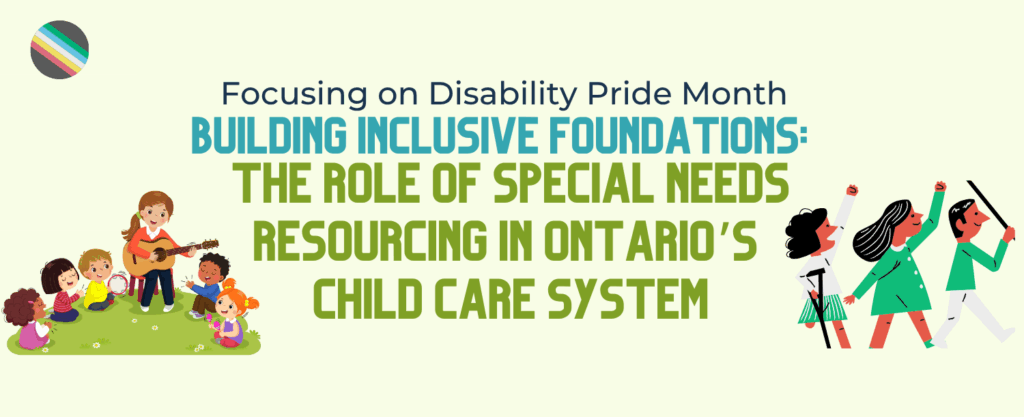By: Michelle Lee
B2C2 acknowledges the Ontario Municipal Social Services Association (OMSSA) for its leadership and research on Special Needs Resourcing (SNR) in Ontario. This blog draws on findings and recommendations from OMSSA’s 2024 report, which reflects the experiences of Ontario’s 47 Service System Managers in planning and delivering inclusive child care services across the province.
Ontario’s child care sector is undergoing a significant transformation. With the rollout of the Canada-Wide Early Learning and Child Care (CWELCC) system and the promise of $10-a-day care, there’s growing optimism about affordability. But for families and inclusion advocates, one question remains top of mind: Will the system also work for children with special needs?
What is Special Needs Resourcing?
Special Needs Resourcing (SNR) is a foundational support system that allows children with developmental, physical, emotional, or communicative needs to participate meaningfully in licensed child care programs. SNR includes enhanced staffing supports, access to resource consultants, specialized equipment, and professional development for educators.
Progress and Promise
Ontario’s Access and Inclusion Framework (2023) sets a strong vision: all children, regardless of ability or background, should experience belonging and participation in early learning environments. The framework is grounded in principles of equity, accessibility, and universal design, aligning with human rights commitments and Indigenous reconciliation goals.
Ontario’s 47 Service System Managers (SSMs)—the municipal and district bodies responsible for child care planning—play a key role in delivering on this vision. As reported by the Ontario Municipal Social Services Association (OMSSA), many SSMs are developing tailored solutions: embedding resource consultants in programs, forming partnerships with clinical experts such as speech and occupational therapists, and adapting services to local needs.
Importantly, SNR services are offered at no cost to families. But as the sector grows, the system that supports inclusion is under increasing strain.
Current Challenges
Despite strong policies and local efforts, SNR services face growing pressure:
- Rising Demand: As more licensed spaces are created under CWELCC, the demand for inclusive supports grows. Many SSMs report increased referrals and longer waitlists for SNR services.
- Workforce Shortages: Limited availability of trained Registered Early Childhood Educators (RECEs) and Inclusion Consultants has made it difficult to meet needs, especially in rural and remote regions.
- Funding Gaps: Current provincial policy restricts CWELCC funding from being used to support SNR. This creates a disconnect—how can inclusion be a pillar of CWELCC if inclusion supports are excluded from the funding model?
Moving Forward: Collaborative, Constructive Solutions
The good news is Ontario already has a thoughtful blueprint. The Access and Inclusion Framework outlines core values—equity, participation, belonging, and universal design—grounded in a rights-based approach. The province has also committed to working with SSMs to identify barriers and measure progress.
And on the ground, many SSMs are leading the way. Through flexible service models, embedded consultants, and ongoing educator training, they are demonstrating what’s possible when inclusion is prioritized.
To ensure that Ontario’s $10-a-day child care system is truly inclusive, we can build on existing strengths:
- Integrate SNR into CWELCC Funding
The OMSSA recommends making SNR a core, fully funded part of CWELCC. This would allow Service System Managers to meet growing demand without reallocating funds or implementing waitlists.
- Support the Child Care Workforce
Enhancing RECE compensation and including inclusion training in ECE college curricula can reduce burnout and improve program quality. A sustainable wage grid, similar to that of school board educators, would be a step in the right direction.
- Maintain Local Flexibility
Local managers know their communities. Preserving flexible funding guidelines allows municipalities to tailor SNR services in ways that make sense regionally—whether through enhanced staffing, partnerships with clinical experts, or community-led training initiatives.
- Embrace Inclusive Planning
The Access and Inclusion Framework encourages service managers to use data and consultation to identify where barriers to inclusion exist. Transparent planning, community engagement, and strong accountability mechanisms can help Ontario track progress and improve outcomes for children with special needs.
Inclusion Is Not Optional
Inclusion is not a luxury—it’s a right, and a cornerstone of equitable child care. Ontario has made strong commitments through CWELCC and the Access and Inclusion Framework. Now it must ensure these commitments translate into reality for every child.
By embedding Special Needs Resourcing into the heart of the $10-a-day system, Ontario can lead the way toward a truly universal and inclusive child care model—one where no child is left behind.


